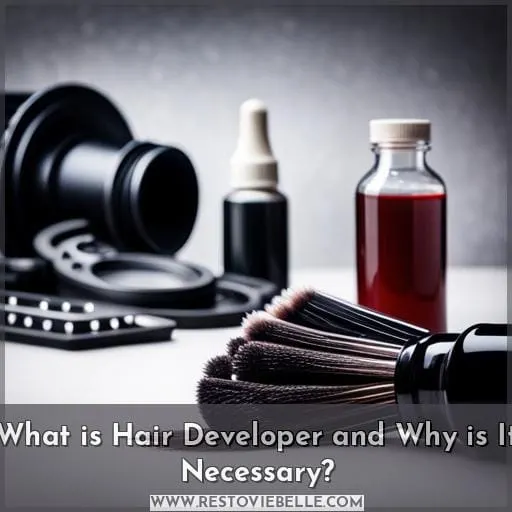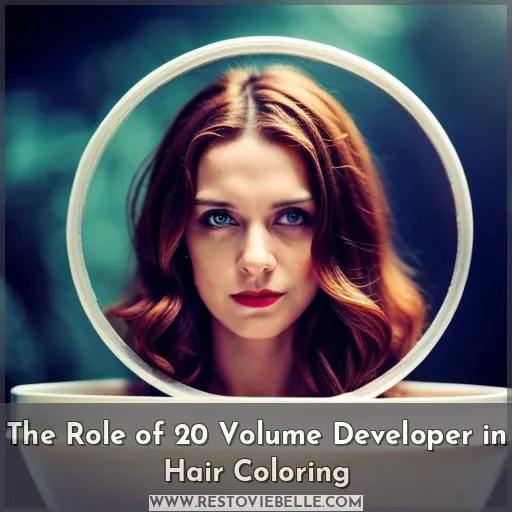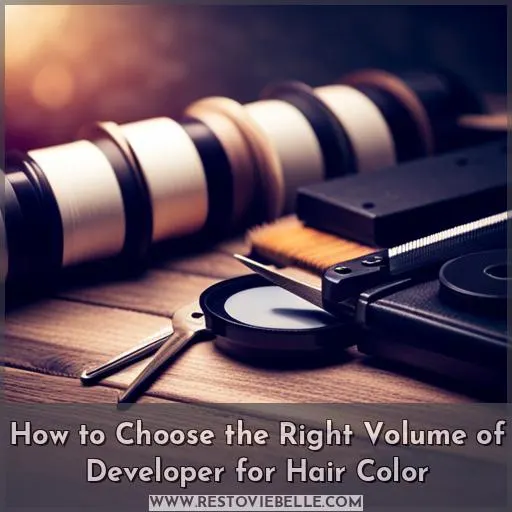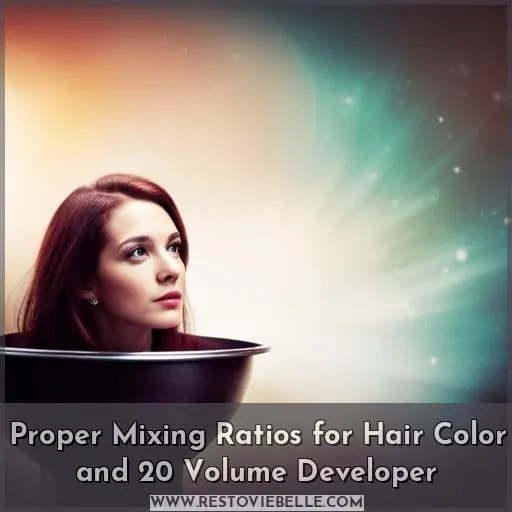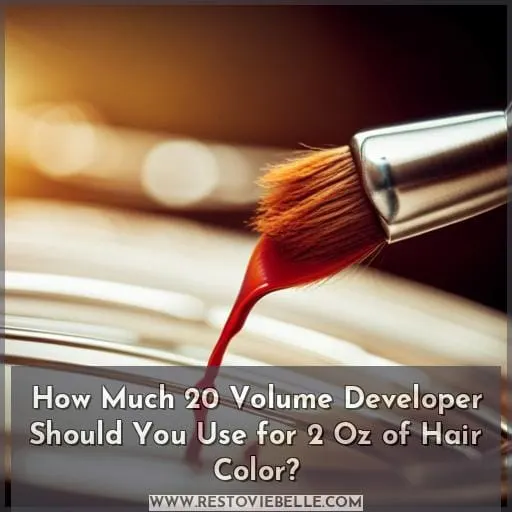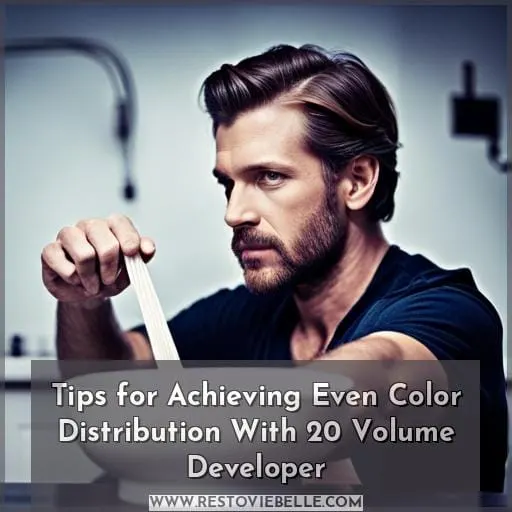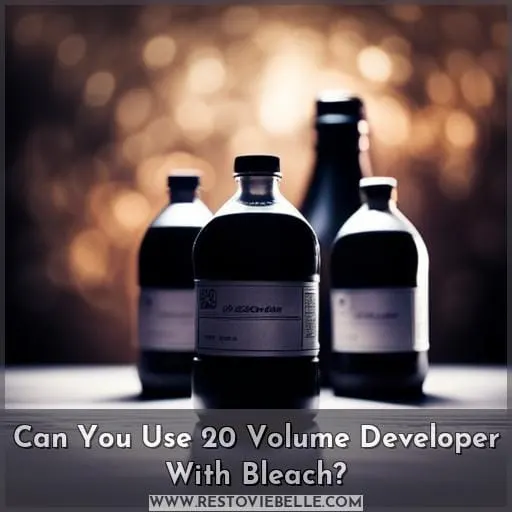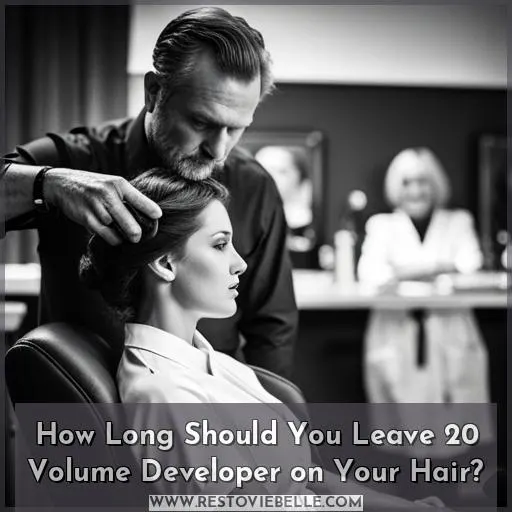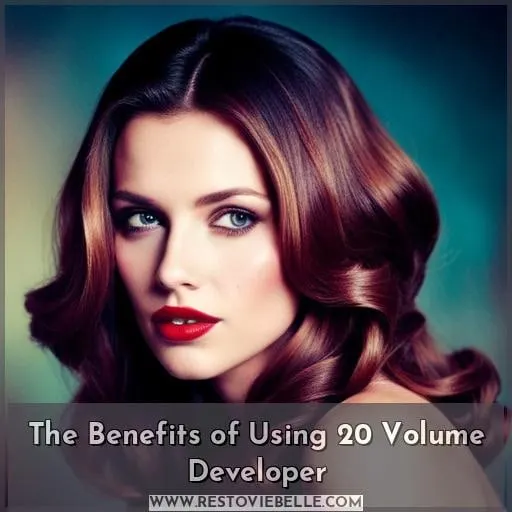This site is supported by our readers. We may earn a commission, at no cost to you, if you purchase through links.
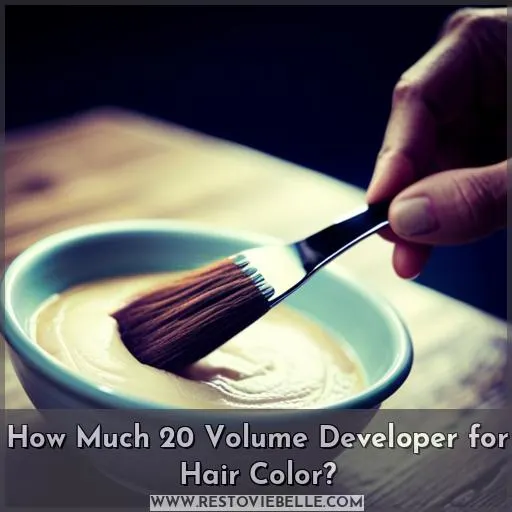 Ready to take your hair game to the next level? Buckle up because we’re diving into the world of hair coloring and developers!
Ready to take your hair game to the next level? Buckle up because we’re diving into the world of hair coloring and developers!
So, how much 20 volume developer should you mix with dye? Fear not, I’m here to guide you through everything.
The correct ratio depends on factors like hair length and desired outcome. Thicker or longer hair may require a different ratio for even color distribution.
Get ready for fabulous results!
Table Of Contents
- Key Takeaways
- What is Hair Developer and Why is It Necessary?
- The Role of 20 Volume Developer in Hair Coloring
- How to Choose the Right Volume of Developer for Hair Color
- Proper Mixing Ratios for Hair Color and 20 Volume Developer
- How Much 20 Volume Developer Should You Use for 2 Oz of Hair Color?
- Tips for Achieving Even Color Distribution With 20 Volume Developer
- Can You Use 20 Volume Developer With Bleach?
- How Long Should You Leave 20 Volume Developer on Your Hair?
- The Benefits of Using 20 Volume Developer
- Frequently Asked Questions (FAQs)
- Conclusion
Key Takeaways
- 20-volume developer is used to open the hair cuticle and allow color molecules to penetrate deeply into the hair fiber.
- The recommended mixing ratio for hair color and 20-volume developer is usually 1:1.
- 20-volume developer is suitable for moderate changes and achieving vibrant colors without excessive damage to the hair.
- It can be used with permanent hair dye, semi-permanent hair dye, or even highlights.
What is Hair Developer and Why is It Necessary?
Hair developer is a necessary component in the hair coloring process as it helps activate and penetrate the hair dye into your strands. It contains hydrogen peroxide, which opens the cuticle of your hair, allowing the color molecules to enter and create a lasting effect.
Whether you’re covering gray hair or simply changing your shade, using a developer is essential for achieving desired results.
Developers come in different volumes, with 20 volume being commonly used for at-home coloring.
When mixed with bleach, developer lifts the natural pigment from your hair to achieve lighter shades.
It’s important to follow mixing ratios specified on product instructions to ensure even color distribution and minimize damage risks associated with improper use of developers.
The Role of 20 Volume Developer in Hair Coloring
When it comes to hair coloring, 20 volume developer plays a crucial role in achieving your desired results.
It opens the hair cuticle, allowing color molecules to penetrate the hair fiber and customize the intensity and shade of your color.
However, using too much 20 volume developer can lead to hair damage, so it’s important to follow recommended ratios for mixing with bleach or dye.
How Does 20 Volume Developer Work?
When using 20 volume developer for hair coloring, it plays a vital role in the process by:
- Opening the hair cuticle and allowing color molecules to penetrate deeply into the hair fiber.
- This helps to lighten the hair and customize the color intensity and shade.
- Ensuring even distribution of color throughout your strands, resulting in a more uniform look.
It’s an essential component when achieving desired results with your chosen hair color.
Effects of Using Too Much 20 Volume Developer
If you use too much 20 volume developer, it can cause damage to your hair.
Excessive use of 20 volume developer can lead to:
- Dry hair
- Breakage
- Frizz
- Even hair loss
The high concentration of hydrogen peroxide in the developer strips away the natural oils and moisture from your strands, leaving them brittle and prone to damage.
It’s important to follow recommended guidelines for mixing ratios to avoid these negative effects on your hair when coloring with a 20 volume developer.
How to Choose the Right Volume of Developer for Hair Color
When choosing the right volume of developer for your hair color, it’s important to consider the desired outcome and the level of change you want to achieve.
- Higher volumes are used for lightening hair.
- Lower volumes are better suited for darkening or covering grays.
Using too much developer can lead to hair damage, so it’s important to follow mixing ratios and application instructions carefully.
Choosing the correct volume
Now that you understand the role of 20 volume developer in hair coloring, let’s discuss how to choose the correct volume for your hair color.
- Higher volume developers are used for lightening hair by one or two levels.
- Lower volume developers are suitable for darkening hair or covering grays.
- 20 volume developer is a good choice for moderate changes and achieving vibrant colors without causing excessive damage to your hair.
Remember: Always follow the instructions on the developer bottle and use a proper mixing ratio (such as 1:1) to ensure optimal results with minimal risk of damage.
Mixing ratio for color
To achieve the best results when mixing hair color, you should always use a 1:2 ratio of hair color to 20 volume developer.
This means that for every part of hair color, you’ll need two parts of developer.
For example, if you’re using 2 oz of hair color, you’ll need to mix it with 4 oz (or twice as much) of 20 volume developer.
This ratio ensures proper activation and allows the developer to lift your natural pigment and lighten your hair effectively.
| Hair Color | Volume Developer |
|---|---|
| 2 oz | 4 oz |
Avoiding hair damage
To avoid hair damage, it’s important to choose the right volume of developer for your hair color.
Using a higher volume developer than necessary can lead to overprocessing and chemical damage.
To prevent this, opt for a lower volume like 10 or 20 when darkening your hair or covering grays.
Additionally, using products like argan oil, deep conditioner, and heat protectant can help minimize potential damage during the coloring process.
Proper Mixing Ratios for Hair Color and 20 Volume Developer
To achieve the best results when mixing hair color with 20 volume developer, it’s important to follow proper mixing ratios and guidelines.
- Ratio: The recommended ratio for mixing hair color and 20 volume developer is usually 1:1 or equal parts of each. This ensures that the two components are properly blended together.
- Hair Color Type: You can use 20 volume developer with permanent hair dye, semi-permanent hair dye, or even highlights. It helps in opening up the cuticle of your strands and allows for better penetration of color molecules.
- Gray Hair Coverage: If you have gray hair that needs coverage, using a higher volume developer like 20 can be beneficial as it provides more lift and better pigment absorption.
By following these guidelines for proper mixing ratios when using 20 volume developer with your chosen hair color product, you’ll be on your way to achieving vibrant and long-lasting results.
How Much 20 Volume Developer Should You Use for 2 Oz of Hair Color?
When mixing hair color and 20 volume developer, you should use approximately 2-4 ounces of developer for every 2 ounces of hair color.
Here are some tips to help you mix your hair color and developer effectively:
- Use a plastic bowl to mix the ingredients.
- Use a mixing brush to combine the hair color and developer thoroughly.
- If desired, add a few drops of argan oil to the mixture for added moisture.
By following these guidelines, you can ensure that your hair color is mixed properly with the right amount of volume developer. This will result in vibrant and even-colored locks that showcase your style beautifully.
Tips for Achieving Even Color Distribution With 20 Volume Developer
For achieving even color distribution with 20 volume developer, start by applying the hair color mixture at the roots and working your way down.
Here are some tips to help you achieve a flawless result:
- Avoid using metal utensils: Metal can react with the developer and alter the color outcome. Stick to plastic or glass bowls and brushes.
- Use a digital scale for precision: Measuring your hair dye and developer in precise amounts will ensure an accurate ratio of 1:1 or 1:2.
- Start at the roots and work your way down: This technique allows for better coverage of gray hairs and ensures that all sections receive equal coloring.
- Apply conditioner after rinsing out color:
Conditioning helps restore moisture lost during coloring process, leaving hair silky smooth.
By following these tips, you can achieve beautiful results with even distribution when using 20 volume developer in your hair coloring process.
Can You Use 20 Volume Developer With Bleach?
Yes, you can use 20 volume developer with bleach to achieve a lighter hair color.
When combined with bleach, 20 volume developer helps to lighten the hair by opening up the cuticle and allowing the bleach molecules to penetrate the hair fiber. This combination gives you more control over the intensity and shade of your desired color.
However, it’s important to note that bleaching can cause damage to your hair if not done properly or if used excessively. It’s recommended to follow instructions carefully and avoid leaving the mixture on for too long as this can lead to excessive damage.
Always maintain a proper ratio of one part bleach to two parts 20 volume developer for best results.
How Long Should You Leave 20 Volume Developer on Your Hair?
To achieve optimal results, it’s important to know how long you should leave 20 volume developer on your hair.
- Leave the 20 volume developer on your hair for a maximum of 30 minutes. This allows enough time for the color molecules to penetrate the hair fiber and create a lasting effect.
- However, if you have sensitive or damaged hair, it’s recommended to leave the developer on for only 15 minutes. This helps minimize any potential damage that could occur from extended exposure.
- It’s crucial not to exceed these recommended times as leaving the developer on for too long can lead to excessive drying and damage.
The Benefits of Using 20 Volume Developer
Using 20 volume developer for your hair color has several benefits.
First, it allows you to achieve the proper ratio of developer-to-color, ensuring that the color develops correctly and evenly.
Second, it helps to avoid hair damage by providing a moderate level of lift without causing excessive lightening or potential harm to your strands.
Lastly, using 20 volume developer promotes even color distribution throughout your hair for a more professional-looking result.
Proper developer-to-color ratio
Are you wondering what the proper developer-to-color ratio is for using 20 volume developer and why it’s beneficial?
The mixing ratio of hair color to 20 volume developer can vary depending on the desired results.
A common ratio is 1:1, where equal parts of color and developer are used.
Another option is a 2:1 or a 1:2 ratio, which means two parts color to one part developer or vice versa.
Other ratios like 3:1 or even a more diluted mixture like a 4:1 can also be experimented with for customized shades.
| Developer | Hair Color |
|---|---|
| Equal | Equal |
Avoiding hair damage
Protect your hair from damage by using the correct amount of 20 volume developer in your hair color mixture.
To avoid potential harm, use a deep conditioner after coloring.
When mixing the developer and color, always opt for a plastic bowl instead of metal utensils to prevent unwanted reactions.
Remember to wear gloves during application and follow the recommended processing time on the package—leaving it on too long can lead to hair damage.
Achieving even color distribution
Ensure even color distribution throughout your hair by using 20 volume developer.
To achieve the best results, follow these tips:
- Avoid overlapping sections to prevent uneven coloring.
- Use a brush for application to ensure precise and controlled coverage.
- Start with dry hair to allow the color to penetrate effectively.
- Work in small sections, focusing on one area at a time for thorough saturation.
Remember to process the color for the full recommended time period mentioned on the package instructions.
Frequently Asked Questions (FAQs)
What happens if you use too much 20 volume developer?
Using too much 20 volume developer can cause hair damage.
It’s important to follow the recommended mixing ratios to avoid poor results and potential harm to your hair.
Be precise for vibrant, even color distribution.
What happens if you don’t add enough developer to hair color?
Not adding enough developer to hair color can result in poor results.
The color may not fully penetrate the hair fiber, leading to patchy or uneven coloring.
It’s important to follow the recommended mixing ratios for best results.
How long should you leave a 20 volume developer on?
Leave 20 volume developer on for up to 30 minutes.
This allows the color molecules to penetrate your hair fiber and achieve the desired result.
Does developer make your hair lighter or darker?
Developer neither makes your hair lighter nor darker. It opens the cuticle to allow color molecules to penetrate the hair fiber, but it’s the actual dye that determines whether your hair will be lighter or darker.
Do you need developer when dying hair darker?
When dying hair darker, you don’t need developer if it’s the same shade.
Developer is used to lighten or cover grays.
Make sure to follow instructions for best results and always test a small amount first.
Conclusion
To achieve fabulous hair color results, it’s important to use the correct ratio of 20 volume developer with your hair dye.
Factors like hair length and desired outcome play a role in determining the ideal mixing ratio.
Too much developer can have negative effects on your hair, so it’s crucial to choose the right volume and avoid damage.
By following proper mixing ratios and leaving the developer on your hair for the recommended time, you can achieve even color distribution and enjoy the benefits of using 20 volume developer.
